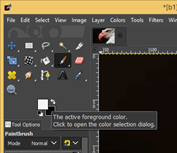

Open the Colors menu and select Hue/Saturation from the list. It’s a bit tricky, but here’s how it works: You could spend your time with the Select By Color tool and then feather your selection edges to create a softer transition, but it’s easier to use the Hue/Saturation filter to adjust a whole range of similar hues all at once. Sharp lines look great in a logo, but they really stand out in a photo. Subtle variations in color tone can make it very hard to get good results with the Select By Color tool, and it looks more natural to have gradual color transitions in a photo. When you’re editing more complex images like digital photos, it’s a bit more unusual to get large sections of the same color next to each other. There is no Step 3 – you’re already done! Hue Adjustments in Complex Scenes Pushing the Hue slider up to 120 or so gives Wilber a fetching teal paintbrush! So much nicer than the orange/brown from before. They work almost identically, except Fuzzy Select only selects contiguous areas of color while Select by Color can create multiple selection areas at once. There are a couple of different ways you can do this, but they’re both found in the same spot in the toolbox: the Select by Color tool and the Fuzzy Select tool. The first step in the color change process is selecting the pixels that you want to modify. Here’s how you can apply it: Step 1: Create Your Selection Pixel art, logos, and outlined text are great examples that are perfect for this technique, but it won’t work on pictures with too many aliased pixels. When I say a few colors, I mean from a numerical value perspective: each color should be consistent across the whole image to get the best results. This method works best on a relatively simple image that only has a few colors, such as a GIF or other image that has a limited color palette. This guide is intended for GIMP users who are already fully familiar with the ins and outs of the program, but I’ll explain the steps in more detail down below for those of you who want a bit more detail, along with a technique for creating more gentle color shifts for complex images like photographs. Step 3: Pat yourself on the back, because you’re already done!.Step 2: Open the Colors menu, select the Hue/Chroma filter, adjust the Hue slider until you’re satisfied with the results, and then click OK.Step 1: Use the Select by Color tool to select all the pixels containing the color you want to change.This isn’t always the best way for every image, but here’s the quickest way to change one color into another in GIMP: The Quick Guide to Changing Colors in GIMP The Quick Guide to Changing Colors in GIMP.


 0 kommentar(er)
0 kommentar(er)
